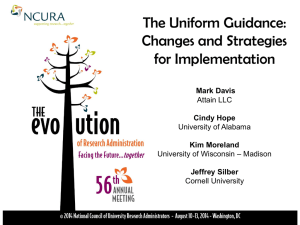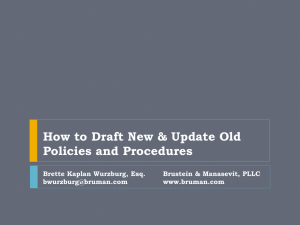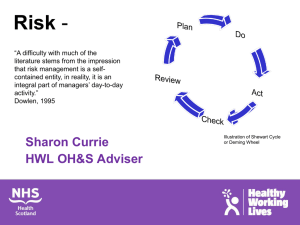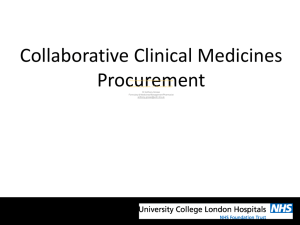PLC Guidance
advertisement
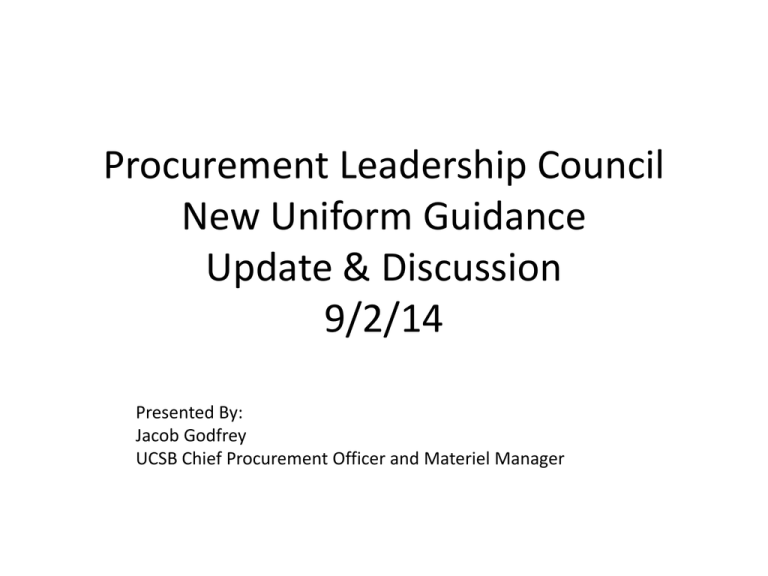
Procurement Leadership Council New Uniform Guidance Update & Discussion 9/2/14 Presented By: Jacob Godfrey UCSB Chief Procurement Officer and Materiel Manager Uniform Guidance Uniform Administrative Requirements, Cost Principles, and Audit Requirements for Federal Awards supersedes and streamlines the following eight existing OMB Circulars: • • • • • • • • A-21 Cost Principles for Educational Institutions A-87 Cost Principles for State, Local and Indian Tribal Governments A-122 Cost Principles for Non-Profit Organizations A-110 Uniform Administrative Requirements for Grants and Other Agreements with Institutions of Higher Education, Hospitals and Other Non-Profit Organizations A-102 Grants and Cooperative Agreements With State and Local Governments A-133 Audits of States, Local Governments and Non-Profit Organizations A-50 Audit Follow-up A-89 Catalog of Federal Domestic Assistance This is a major reform of how the federal government provides assistance awards (e.g., grants and cooperative agreements) with the goal of increasing accountability and transparency while reducing the administrative burden on non-federal entities receiving federal awards. Effective Date When does the Uniform Guidance become effective? • Federal agencies must implement the requirements to be effective by December 26, 2014. • Administrative requirements and cost principles will apply to new awards and to funding increments, in cases where the Federal agency considers funding increments to be an opportunity to modify the terms and conditions of the Federal award, to existing awards made on or after Dec 26, 2014. • Existing Federal awards that do not receive incremental funding with new terms and conditions will continue to be governed by the terms and conditions of the Federal award Effective Date and Procurement The Federal government will provide a grace period of one full fiscal year after the effective date of the Uniform Guidance (December 26, 2014 ) for non-Federal entities to comply with the procurement standards in the Uniform Guidance. However, in light of the new procurement standards, for procurement policies and procedures the non-Federal entity must document whether it is in compliance with the old or new standard, and must meet the documented standard. For example, the first full fiscal year for a non-Federal entity with a June 30th year end would be the year ending June 30, 2016. The Single Audit Compliance Supplement will instruct auditors to review procurement policies and procedures based on the documented standard. For future fiscal years, all non-Federal entities will be required to comply fully with the uniform guidance Impact on Strategic Sourcing • 200.318 (d) & (e) Explicitly encourages non-federal entities to build into their procurement policies practices that consolidate procurements where appropriate to make efficient use of Federal funds. Procurement Claw (Sections200.320 & 200.317-326) Impact on FARS/DFARS Fundamentally unchanged for acquisition of commercial items under federal contacts with FARS flow down provisions UG = Grants FARS = Contracts Micro vs. Small vs. Over Threshold Micro (less than to $3,000) UG FAR Entity must distribute purchases equitably among qualified suppliers (policy?) Price reasonableness may need to justified if contracting officer knows that price is not reasonable or no known comparable pricing exists Entity determines if price is reasonable (document?) Small (less than $150,000) Entity must obtain quotations from an adequate (policy?) number of suppliers and maintain a detailed history of the procurement; quotation sources, basis for selection etc. Entity must obtain at least two quotations, unless small business concern, and document price reasonableness. Over Threshold Competitive proposal or sole source; document method of solicitation, price reasonableness, cost analysis, and basis of award. Competitive proposal or sole source; document method of solicitation, price reasonableness, cost analysis, and basis of award. Conflict of Interest • 200.112 The federal awarding agency must establish conflict of interest policies for Federal awards • 200.318 The non-Federal entity must also maintain written standards of conduct covering organizational conflicts of interests 200.90 State Definition - Warning • 200.90 State means any state of the United States, the District of Columbia, the Commonwealth of Puerto Rico, the Virgin Islands, Guam, American Samoa, the Commonwealth of the Northern Mariana Islands, and any agency or instrumentality thereof exclusive of local governments. • This issue is being examined by UC OGC – impact TBD Subrecipient and Contractor Determination 200.330, 200.22, & 200.92 • It is the substance of the award that determines how it should be treated, even if the pass-through entity or non-Federal entity receiving the award may call it by a different name. Action Items • UC Location to document compliance under old or new standards for the period 7/1/15 6/30/16 • Consider “adequate # quotes” and “method of solicitation” policy • Consider policy on Conflict of Interest • Consider forming workgroup to develop standard policy/procedures/wf Additional Resources UCOP: http://www.ucop.edu/research-policy-analysis-coordination/researchsponsors-agreements/federal-government/uniform-guidance/index.html UCSB: http://www.bfs.ucsb.edu/omb/omb-uniform-guidance





